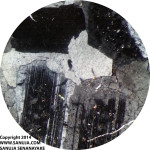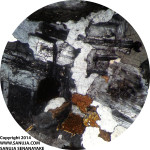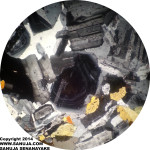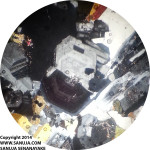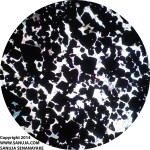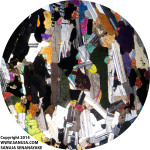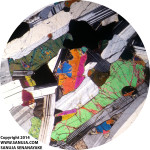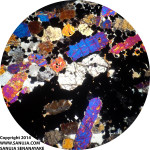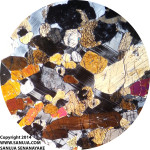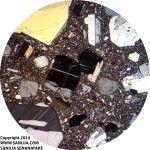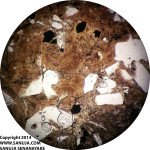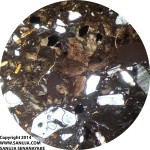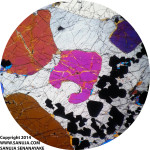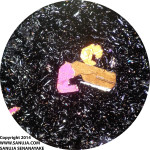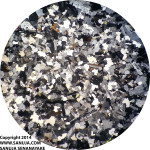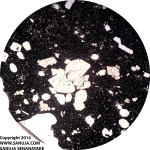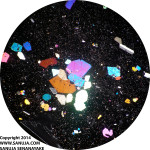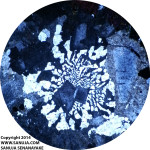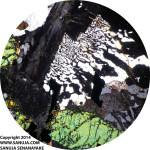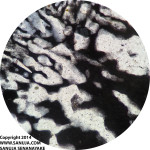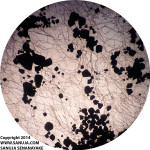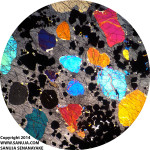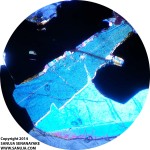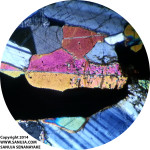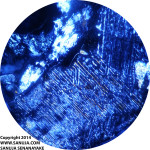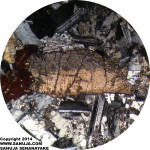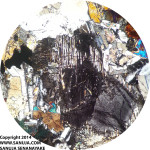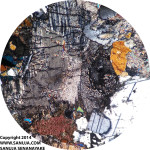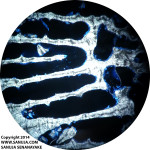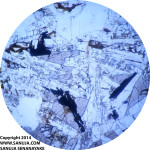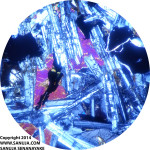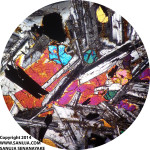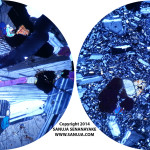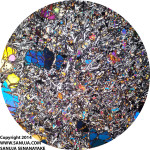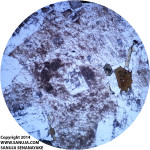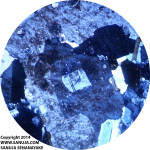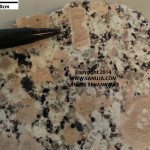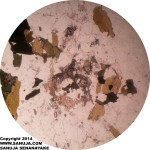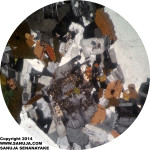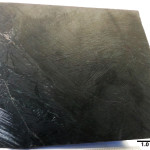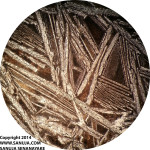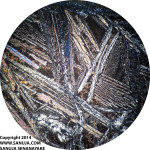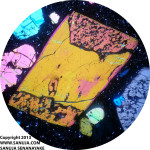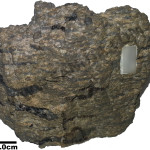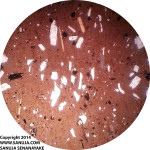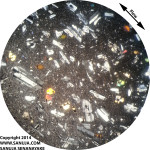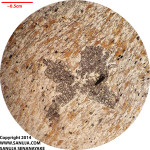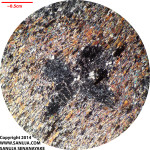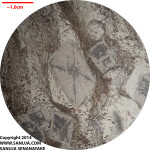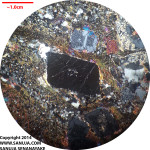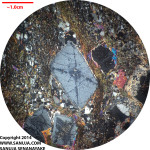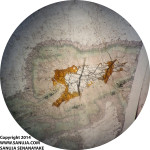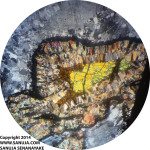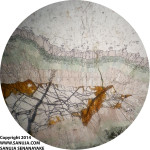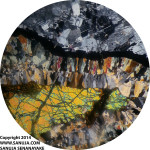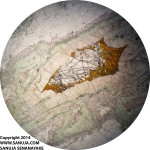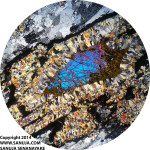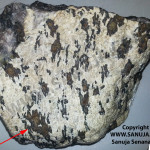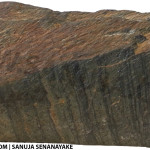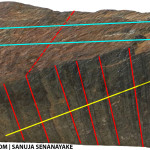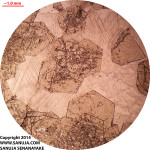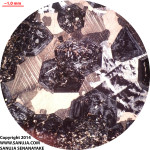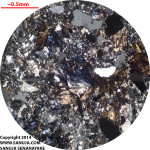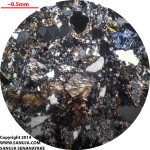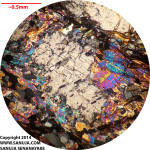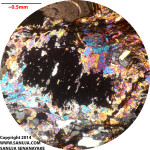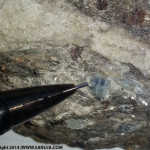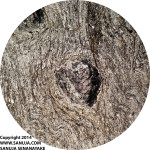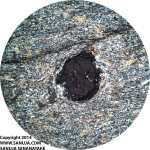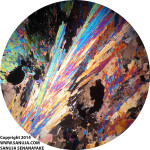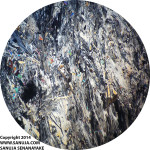The information posted here is not in a particular order. If you want to find something specific on this page, I suggest using page text finder on your computer (Ctrl + F). Important terms and information are in bold. For additional photographs and information, please visit the following pages:
– Mineralogy Media Library
– Photomicrographs of Minerals
– Sedimentary Petrology Media Library
Igneous Petrology
Aphanetic verses Phaneritic Textures
In hand sample, aphanetic describes rocks with very fine grained minerals (hard to see with naked eye). Phaneritic is the opposite of that. In thin section, predominately small crystal size in a sample is described as aphanetic. The image posted under Plutonic versus Volcanic is a good example of Aphanetic (plutonic) verses Phaneritic(volcanic).
Competitive Growth
This is characterized by the wavy boundaries between two or more grains.
Compositional Zoning
As the mineral grows, the chemical composition of the magma in the immediate vicinity evolved. This may cause a variation in chemistry in each layer of addition to the forming mineral. This is most commonly observed in plagioclase feldspars. In plagioclase, concentric bands around the crystal that undergo extinction (XPL) at various angles indicate such zoning. Normal zoning will have albite-rich rim and anorthite-rich core. Reverse zoning will have the opposite. By using an electron microscope or an electron probe, you may determine if it is normal or reverse zoning. Zoning is a type of disequilibrium texture.
Chloritization
It is a type of Chloritization where mafic minerals are converted to chlorite.
Cumulaus Textures
These textures are caused by accumulation of crystals due to gravitational settling (crystal segregation) in a magma chamber.
Cumulaus are the crystals that formed very early. They are usually well formed and euhedral. In “normal” magmatic conditions, one could expect the cumulaus minerals to be upper minerals in Bowen’s Reaction Series (Olivine, Pyroxenes, etc, etc).
Intercumulaus describes the minerals that formed in between the already formed cumulaus grains. Since the space is limited, these crystals often have subhedral to anhedral shape. SOme grains may even have formed with unusual shapes due to limited availability of components and space.
The following image is a near perfect example of cumulate and intercumulate minerals. The Chromite formed first and then Muscovite formed in between.
An example of plagioclase as the cumulaus alongside clinopyroxene as the intercumulus.
An example of Enstatite as the cumulaus with clinopyroxene(cpx) and plagioclase as intercumulus minerals.
Heteradcumulus
Info to be updated… Note that the plagioclase (“background”) in the following image is in extinction.
Also research on Orthocumulate and Adcumulate textures.
Cumulophyric Texture
Please read Glomeroporphyritic Texture
Deformation Twins
Occur on albite twining on plagioclase and on calcite. Deformation twins lack straight lamellar form, which is observed in normal twins. They are characterized by the wedge shaped or bent twins. About 3 mm across the image.
Devitrification
Devitrification characterized by spherulites and perlitic cracks.
Embayment
The embayed texture is characterized by having “dips” or bay-like sections in the crystal as a result of resorption. This is a type of disequilibrium texture.
Equigranular Texture
The sample has grains about the same size. Opposite term is ineuigranular. Also check the image for Cumulaus Textures.
Glomeroporphyritic Texture
Clusters of phenocrysts crystals involving one type of mineral. The term cumulophyric is used when there are more than one type of mineral in a cluster.
Granophyric Texture
This texture is produced as a result of rapid undercooling of quartz and feldspars. The two minerals grow at the same rate at the same time (simultaneous growth). The process is usually triggered by loss of water/dehydration in a granitic melt. They do not form as single crystals but rather penetrate each other in an irregular branching like intergrowths. Under microscope (XPL), the quartz intergrowths will undergo extinct at the same time.
Interstitial Texture
The background of the phenocrysts are one large feldspar. Also related to Cumulaus Textures because “interstitial” is a descriptor/modifier.
Inverted Pigeonite
Characteristic of magmas which underwent rapid cooling. Commonly formed in rocks with plutonic origin. Also known as herringbone exsolution. Note that the first two pictures may or may not be inverted pigeonite. However, they also have the exsolution features and could be a partial representation of it. The last image shows what we ideally called inverted pigenoite.
K-feldspar type Exsolution
Caused by limited chemical mixing in the magma. Most commonly seen in K-feldspar with respect to Na-rich verses K-rich chemical environments (also read prethite verses antiperthite in notes or textbook). It can also occur on plagioclase with Si-Al chemical environments. Also check images under Poikilitic Texture
Ophitic, Subophitic and Nesophitic textures
The term ophitic is used when large pyroxene grains enclose small, random plagioclase laths. The proportion of pyroxenes is much larger than that of plagioclase.
The term subophitic is used when larger plagioclase laths are partially enclosed by pyroxene grains. The volumetric proportion of plagioclase is higher than that of pyroxenes. The two images are examples of nesophitic texture. Images shows subophitic texture.
The term nesophitic is used when large plagioclase has smaller interstitial pyroxenes. The volumetric proportion of the plagioclase is higher.
Plutonic versus Volcanic
On the following picture, the left one is a thin section from a plutonic rock and the right one is from a volcanic rock. The difference is in the groundmass and the crystal growth. Finer grained groundmass is indicative of volcanic rocks. Volcanic rocks usually have more ground massvolume (relative to the larger crystal volume). Well formed euhedral crystals are indicative of plutonic rocks and they usually have less groundmass volume. Both images have exact same resolution with about 2.8 mm across each Field of View (width).
Pilotaxitic Texture
Groundmass crystals are randomly oriented.
Poikilitic Texture
This is a type of porphyritic texture in which a host phenocryst (known as oikocryst) contains one or more other mineral(s) inclusions. This is caused by magmas that underwent slow cooling (undercooling) first stage and later underwent rapid cooling. During the first stage, smaller crystals were formed. During the last stage, these smaller crystals will be included within the larger faster cooled crystal. The easiest poikilitic grains to identify under microscope have usually only one grain inclusion (picture below). You can also see the faint perthitic exsolution on both PPL and XPL images.
Pseudomorph Texture
It is a type of replacement texture in which one or several minerals replaces another already formed mineral. The new replacement mineral(s) will maintain the size and shape of the original one.
Rapakivi Texture
It is an overgrowth of plagioclase minerals on alkali feldspar mineral. This texture is caused by epitaxial (heterogeneous) nucleation where new nuclei is formed on a per-existing crystal. In most cases, this can be easily recognizable in hand samples.
Seritization
It is a replacement process in which feldspars and/or feldspathoids by fine white micas. This is observed as a fined dust like (dotted) appearance on feldspars. This texture is caused by hydrothermal alteration.
Skeletal Texture
TO BE UPDATED…
Spinifex Texture
Usually easy to recognize in hand samples. They are sub-parallel to dendritic growth of olivine or clinopyroxene crystals in some quenched ultramafic rocks generated from lava flows.
Sieve Texture
The following image shows a mineral (olivine) that has been formed in two different chemical conditions. The larger euhedral crystal is the initial crystal. After most of the initial crystal has formed, the mineral has started to remelt producing a slightly different composition of olivine at the corners (top right and bottom left). This process is known as resorption. An electron microprobe may be used to analyze the the chemical differences between them. This is a type of disequilibrium texture.
Trachyte Texture
Caused by alignment of minerals (usually the elongated minerals such as feldpars) due to flow. Found in aphanetic rocks and easy to observer in hand samples than thin sections.
Xenolith verses Xenocryst
Xenolith is an inclusion of country rock. Xenocryst is an inclusion of a foreign crystal that may or may not be from the country rock (eg. Olivine).
Metamorphic Petrology
Andalusite
First two pictures: a beautiful example of Andalusite “cross” in PPL and XPL.
Coronas
Corona is a rim (or several successive rims=coronas) of one or several minerals surrounding another unstable mineral. These reaction rims are formed as a result of partial replacement of minerals at the grain boundary of the unstable mineral (middle). This is a solid state process.
Order of minerals for this particular example is; Olivine (center) – Orthopyroxene – Clinopyroxene – Hornblende- Spinel – Garnet – Plagioclase (outer most). This is the most common order of coronas(??).
Fabric Types
To be updated…
Grossular Garnet
Garnet is isotropic (remain extinct under XPL). However, grossular garnet will have zoning like layers within it.
Jadeite
Fiber like appearance with blue-brown interference colours.
Kyanite
Porphyroblasts
The following two images shows Garnet as a porphyroblast. By definition, porphyroblast is a larger crystal grown within a finer grained groundmass.
Tremolite
Fibrous like Wollastonite but bright interference colours than Wollastonite. Not to be confused with Wollastonite.
Wollastonite
Fibrous but lower interference colours than Tremolite. Not to be confused with Tremolite.

